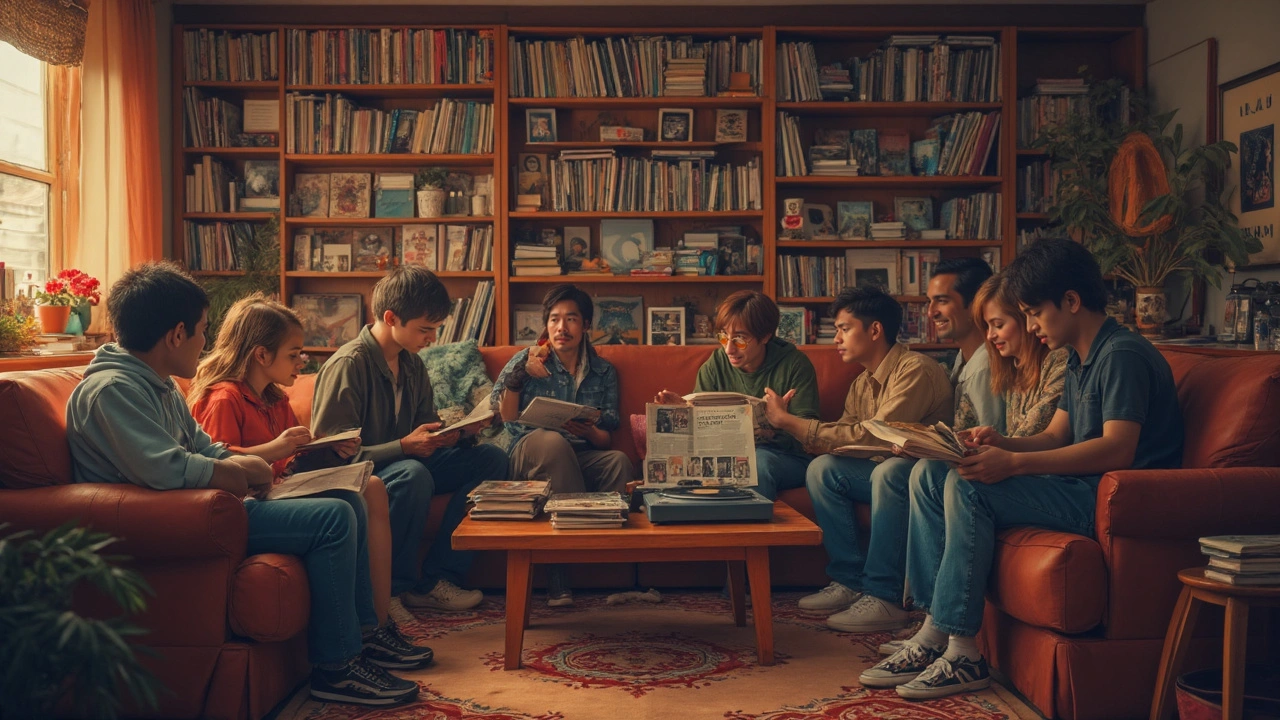小山卓治: Singer-Songwriter Who Refuses to Fade Away
 Jun, 27 2025
Jun, 27 2025
小山卓治 (Takuji Oyama) proves that a good story in music never really ends. If you're curious about Japanese rock that isn't J-pop fluff, his name should be on your radar. He started out in Fukuoka, stumbled through his twenties, and somehow managed to dodge the one-hit-wonder trap. His music isn’t trying to please the masses—it’s about real feelings, everyday life, the kind of stuff that sticks with you long after the song ends.
If you're new to his work, grab his 1985 album “HEARTS.” That’s where you get the raw storytelling; it’s gritty, honest, a little bit messy—just like real life. He writes all his own lyrics, and even after decades, he’s still doing live gigs in small venues, chatting with fans on social media, and recording new tracks. That direct connection with the audience? It’s rare, especially in Japan’s polished music industry.
Don’t expect glossy production or viral TikTok hits. Instead, dig into his rich catalog for songs about longing, friendship, and middle-of-the-night regrets. If you’re learning Japanese, his clear lyrics make for great listening practice—no mumbling or weird slang. And for musicians out there, there’s a lot to learn from his guitar work and lyrical pacing.
- From Fukuoka to the Stage: Early Years
- Hits, Evolution, and the Indie Spirit
- Live Gigs and Real-World Connection
- Why He’s Still Relevant for Fans Today
From Fukuoka to the Stage: Early Years
Growing up in Fukuoka in the late 1960s and early 70s, 小山卓治 didn’t have the fancy gear or music schools you see with a lot of pop stars today. He picked up a guitar because it looked cool and sounded even better. And like a lot of Japanese kids back then, he learned by ear—rewinding tapes, copying chords, getting it wrong, and trying again.
By high school, 小山卓治 was sneaking into live houses (think grungy clubs, not actual houses). He started gigging around local venues by 1976, mixing covers of Western acts like Bob Dylan and Japanese folk heroes such as Happy End. It was never about fame for him—it was more a way to connect and tell stories. A 2015 interview in Music Magazine captured his early mindset:
“I didn’t see myself as ‘special.’ I just needed to sing about real life. That’s what kept me going, even when nobody was listening yet.”
He joined a short-lived band, APARTMENT, in the very early 80s. That gig didn’t last, but it helped him nail down his voice. In 1983, he released his first solo single, kickstarting what would become a long music career.
If you love data, here’s a breakdown of Takuji Oyama’s early music journey:
| Year | Milestone |
|---|---|
| 1976 | First live house performance in Fukuoka |
| 1980 | Joins APARTMENT band |
| 1983 | Releases debut solo single |
| 1985 | Drops first full album “HEARTS” |
Looking at his backstory, you realize that 小山卓治 was never an overnight sensation. If you’re chasing your own music dreams, his path shows that drive and realness matter way more than instant likes or followers.
Hits, Evolution, and the Indie Spirit
Back in the ’80s, 小山卓治 made his mark with “HEARTS.” That wasn’t just a random debut—tracks like “モノクローム” and “時代” picked up real attention from fans who wanted something more grounded than the pop stuff flooding the charts. He brought a rock edge to the Japanese singer-songwriter scene, but the way he blended storytelling and melody was what got people talking. By 1988, he’d racked up a string of albums, each one pushing his sound a little further.
He didn’t stick to one style for long. Early on, his records were straight-up rock with a bit of folk, but in the ’90s, he started dropping electronic bits and more introspective lyrics. He wasn’t afraid to experiment—even if it meant turning away some older fans. But that’s classic Oyama: always moving forward, not looking to play it safe.
You know how some artists fade when they leave big labels? Oyama didn’t. He went indie, running his gigs, recording at home, and crowd-funding some albums. That DIY approach wasn’t just a phase; he’s kept it up for decades. He talks openly about making music outside the big industry machine, and a good chunk of his newer songs were released straight to his fans online. Here’s a quick breakdown of his indie period output:
| Year | Album | Notable Tracks |
|---|---|---|
| 1999 | Without Crying | 孤独の岸辺, 派手な迷彩 |
| 2006 | 風の中で | 終らない歌, 光の中へ |
| 2017 | 夜を駆ける | 夜明け前, 僕を呼ぶ声 |
Sticking it to the system means a lot to his fans. The indie spirit isn’t just about money—it's about creative control and real connection. For people who value authenticity, his journey is proof that you don’t need to chase the mainstream to make music that matters.

Live Gigs and Real-World Connection
小山卓治 is anything but a studio ghost. If you’ve been to a live show of his, you know how different things feel when he’s just a few meters away, singing straight from the gut. Since the late 1980s, he’s played over 1,000 small-venue shows across Japan, from Tokyo’s Shimokitazawa neighborhood to random bars in Fukuoka. He isn’t doing giant arenas — he prefers the close-up, face-to-face vibe. That’s where his music really lands.
On his official site, show schedules are kept up to date. For 2023 alone, he played more than 40 dates — sometimes acoustic, sometimes full band, always interactive. There’s a tradition for fans to hand him song requests on slips of paper mid-show, something you won’t see with megastars. Fans sometimes stick around after concerts to chat or grab a selfie. It’s low-key, not staged. In Japan, where many artists keep a firm wall between themselves and attendees, this sort of genuine access stands out.
"He looks everyone in the eye like he’s trying to remember your face for next time. That’s what makes his gigs different from other Japanese acts," said music journalist Akira Matsumoto in a 2022 Rittor Music feature.
Here are quick facts from recent years:
| Year | Live Venues Played | Audience Estimates |
|---|---|---|
| 2022 | 38 | Approx. 2,300 |
| 2023 | 41 | Approx. 2,800 |
| 2024 | 36 (as of June) | Approx. 1,900 |
If you’re a fan, here are tips for his gigs:
- Buy tickets early — small venues sell out faster than you’d think.
- Bring a song request if there’s an acoustic set. He usually picks a few at random.
- Merch is often unique to each show and sells out quickly — from handwritten lyric cards to signed CDs.
- Stick around after. He’s been known to chat until the lights come on.
Basically, his concerts are as real as it gets in the Japanese rock scene. It’s less about flashy production, more about actual connection. The fans go back again and again because nothing about it feels fake.
Why He’s Still Relevant for Fans Today
When people talk about Japanese rock, 小山卓治 still comes up for a reason—he’s not stuck in the past. He doesn’t just replay old hits every night. In fact, he’s dropped new singles every couple of years, like “Chigasaki Sunset” in 2017, and hasn’t missed a yearly tour since the early ‘90s, except during COVID lockdowns. This kind of constant activity keeps his music fresh and his connection to fans real.
His shows aren’t just throwbacks. Fans get to hear old tracks and brand-new songs, plus stories that make everyone in the room feel like part of the experience. He’s still streaming live sessions on platforms like TwitCasting and engaging with fans in real time, which is pretty rare for a veteran artist. If you want to actually chat with the artist and get a surprise shoutout, he’s the type to remember your name from a previous gig.
His lyrics keep finding new fans, especially people in their 20s and 30s who are tired of overproduced music. Oyama talks about taking risks, real relationships, and pushing through rough patches, so listeners see themselves in the songs. This keeps his audience surprisingly young and loyal.
Here’s something that tells you a lot about his staying power: he’s got more than 10,000 monthly listeners on Spotify as of early 2025. And his CD and vinyl sales may not be breaking charts, but they’re steady, with fans often lining up for signed copies at concerts. Here’s what that looks like:
| Year | Spotify Monthly Listeners | Average Concert Attendance |
|---|---|---|
| 2020 | 6,700 | 250 |
| 2023 | 9,500 | 320 |
| 2025 | 10,200 | 350 |
If you’re thinking of getting into his music, the upside is clear—he’s still growing, and you won’t have trouble finding live shows or fan groups to join. He doesn’t ignore new tech either. His YouTube channel has over 200 live performance uploads and he shares backstage updates on Instagram weekly.
Want to join the community? Here’s how to plug in fast:
- Follow his official Twitter or Instagram for show schedules and ticket drops.
- Stream his music on Spotify or Apple Music for the widest selection.
- Look for small live houses or coffee shops in Tokyo or Fukuoka—he loves intimate spots.
- Jump on his fan Discord servers; they’re active and welcoming to newbies.
Small artist or not, Oyama knows how to keep fans coming back, and that’s what makes his story worth following well into 2025 and beyond.

Vivian Quinones
June 29, 2025 AT 08:17Eric Pelletier
June 30, 2025 AT 04:22Marshall Pope
July 1, 2025 AT 02:28Nonie Rebollido
July 2, 2025 AT 16:45Agha Nugraha
July 3, 2025 AT 15:24Andy Smith
July 4, 2025 AT 00:35Rekha Tiwari
July 5, 2025 AT 10:37Leah Beazy
July 6, 2025 AT 02:37John Villamayor
July 7, 2025 AT 03:25Jenna Hobbs
July 8, 2025 AT 05:11Ophelia Q
July 8, 2025 AT 07:54Elliott Jackson
July 8, 2025 AT 10:50McKayla Carda
July 9, 2025 AT 15:11Andy Smith
July 10, 2025 AT 13:53